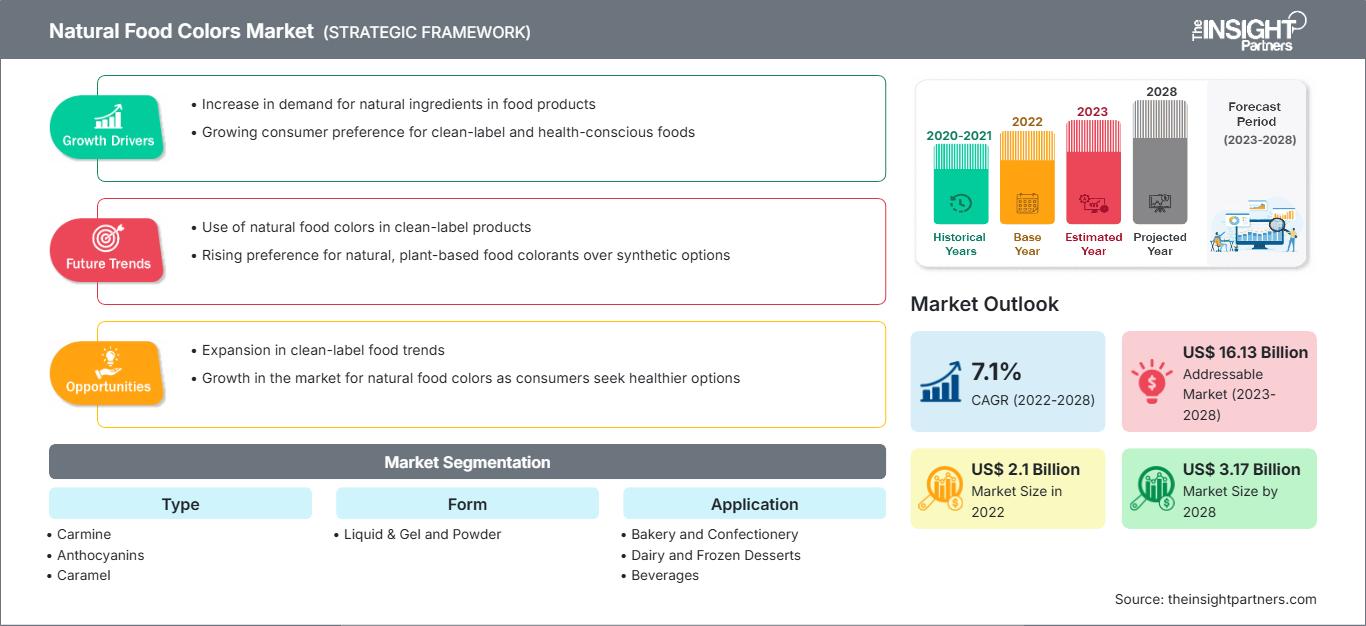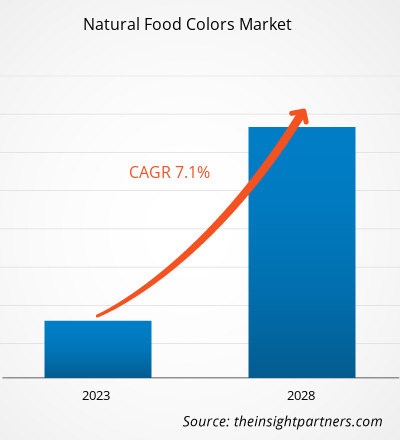[Rapport de recherche] Le marché des colorants alimentaires naturels devrait atteindre 3,17 milliards de dollars américains d'ici 2028, contre 2,10 milliards de dollars américains en 2022. Il devrait croître à un TCAC de 7,1 % entre 2022 et 2028.
La demande de colorants alimentaires naturels augmente, en raison de la sensibilisation croissante des consommateurs aux effets nocifs des colorants synthétiques et du renforcement des réglementations gouvernementales concernant leur utilisation. De nos jours, la plupart des gens sont soucieux de leur santé et optent pour des produits biologiques et naturels. Les colorants alimentaires naturels sont sans danger pour la consommation et améliorent la valeur nutritionnelle des aliments. De plus, ils ne contiennent pas d'ingrédients allergènes courants. Au contraire, ils contiennent des antioxydants qui réduisent le risque de nombreuses maladies. Tous ces facteurs stimulent le marché.
Le marché devrait connaître une croissance significative dans les années à venir grâce à la forte présence d'acteurs de premier plan tels que Koninklijke DSM NV, Sensient Technologies et Archer Daniels Midland Company. Une grande variété de colorants alimentaires naturels a attiré l'attention des consommateurs. On observe une tendance croissante à la consommation de produits alimentaires prêts à consommer et prêts à consommer. Ce facteur devrait offrir de nouvelles opportunités aux fabricants de colorants alimentaires naturels au cours de la période de prévision.
En 2021, l'Europe détenait la part clé du marché mondial des colorants alimentaires naturels. Cependant, l'Asie-Pacifique devrait enregistrer le TCAC le plus élevé du marché au cours de la période de prévision. Le marché Asie-Pacifique est segmenté en Chine, Inde, Australie, Japon, Corée du Sud et reste de l'Asie-Pacifique. L'industrie agroalimentaire est l'un des secteurs en plein essor en Asie-Pacifique en raison de la croissance démographique et de l'évolution des habitudes alimentaires des consommateurs. Les consommateurs des pays en développement connaissent une forte augmentation de leur revenu disponible, ce qui accroît leur pouvoir d'achat. L’augmentation du revenu disponible des consommateurs et la croissance de la population de la classe moyenne sont parmi les facteurs clés qui stimulent le marché des colorants alimentaires naturels dans la région.
Personnalisez ce rapport en fonction de vos besoins
Vous bénéficierez d’une personnalisation sur n’importe quel rapport - gratuitement - y compris des parties de ce rapport, ou une analyse au niveau du pays, un pack de données Excel, ainsi que de profiter d’offres exceptionnelles et de réductions pour les start-ups et les universités
Marché des colorants alimentaires naturels: Perspectives stratégiques

-
Obtenez les principales tendances clés du marché de ce rapport.Cet échantillon GRATUIT comprendra une analyse de données, allant des tendances du marché aux estimations et prévisions.
Impact de la pandémie de COVID-19 sur le marché des colorants alimentaires naturels
Avant la pandémie de COVID-19, la croissance du marché des colorants alimentaires naturels était principalement tirée par la demande croissante de produits alimentaires biologiques et naturels à haute valeur nutritionnelle. Cependant, le marché a rencontré des difficultés au cours du premier trimestre 2020 en raison de la fermeture des entreprises et des pénuries de matières premières et de main-d'œuvre. La pandémie de COVID-19 a entraîné une récession économique au cours des premiers mois de 2020, ce qui a créé des difficultés financières pour les consommateurs à faibles et moyens revenus.
De plus, en raison des restrictions, les gens sont restés chez eux et ont cuisiné à la maison, créant une demande pour des produits alimentaires emballés et faciles à cuisiner. Cela a fait bondir la demande de produits alimentaires prêts à consommer et prêts à consommer, entraînant la croissance du marché des colorants alimentaires naturels. Les consommateurs sont également devenus soucieux de leur santé et ont privilégié les produits alimentaires naturels et plus sûrs à consommer. Cela a alimenté la croissance du marché pendant la pandémie de COVID-19.
Analyses du marché
Propension croissante des consommateurs à l'égard des produits Clean Label
Nombreux sont ceux qui pensent que les produits alimentaires et les boissons ne sont plus sains que s'ils portent une étiquette avec des ingrédients reconnaissables. L'industrie agroalimentaire est entrée dans une phase de produits Clean Label, ce qui incite les fabricants à adopter des colorants alimentaires naturels pour gagner en compétitivité. Les produits Clean Label attirent également davantage de clients, car les consommateurs sont plus à l'aise avec des produits dont les ingrédients sont connus.
La propension des consommateurs à l'égard des produits Clean Label augmente en raison de la sensibilisation croissante aux questions de santé et à la falsification des aliments. Cela incite les consommateurs à vérifier les étiquettes avant d'acheter un produit. Ce facteur devrait être un moteur crucial pour le marché des colorants alimentaires naturels.
Aperçu de la catégorie
En fonction du type de produit, le marché mondial des colorants alimentaires naturels est segmenté en carmin, anthocyanes, caramel, curcumine, rocou, caroténoïdes, chlorophylle, etc. En 2021, le segment des caroténoïdes représentait la plus grande part de chiffre d'affaires, et le segment des anthocyanes devrait connaître le taux de croissance le plus élevé au cours de la période de prévision. Les colorants alimentaires naturels sont dérivés de plantes, d'animaux et d'autres matières organiques. Ils sont sans danger pour la consommation car ils ne contiennent pas d'ingrédients allergènes.
Koninklijke DSM NV, Sensient Technologies, Archer Daniels Midland Company, Döhler Group, BASF SE, Naturex SA, Aromata Group, Givaudan, Dupont, Oterra A/S et Mane KANCOR figurent parmi les acteurs opérant sur le marché. Ces entreprises proposent une large gamme de produits. Implantées dans les régions en développement, elles offrent des débouchés lucratifs. Les acteurs du marché développent des produits innovants et de haute qualité pour répondre aux exigences des clients.
Aperçu régional du marché des colorants alimentaires naturels
Les tendances régionales et les facteurs influençant le marché des colorants alimentaires naturels tout au long de la période de prévision ont été analysés en détail par les analystes de The Insight Partners. Cette section aborde également les segments et la répartition géographique du marché des colorants alimentaires naturels en Amérique du Nord, en Europe, en Asie-Pacifique, au Moyen-Orient et en Afrique, ainsi qu'en Amérique du Sud et en Amérique centrale.
Portée du rapport sur le marché des colorants alimentaires naturels
| Attribut de rapport | Détails |
|---|---|
| Taille du marché en 2022 | US$ 2.1 Billion |
| Taille du marché par 2028 | US$ 3.17 Billion |
| TCAC mondial (2022 - 2028) | 7.1% |
| Données historiques | 2020-2021 |
| Période de prévision | 2023-2028 |
| Segments couverts |
By Type
|
| Régions et pays couverts |
Amérique du Nord
|
| Leaders du marché et profils d'entreprises clés |
|
Densité des acteurs du marché des colorants alimentaires naturels : comprendre son impact sur la dynamique commerciale
Le marché des colorants alimentaires naturels connaît une croissance rapide, porté par une demande croissante des utilisateurs finaux, due à des facteurs tels que l'évolution des préférences des consommateurs, les avancées technologiques et une meilleure connaissance des avantages du produit. Face à cette demande croissante, les entreprises élargissent leur offre, innovent pour répondre aux besoins des consommateurs et capitalisent sur les nouvelles tendances, ce qui alimente la croissance du marché.

- Obtenez le Marché des colorants alimentaires naturels Aperçu des principaux acteurs clés
- Analyse historique (2 ans), année de base, prévision (7 ans) avec TCAC
- Analyse PEST et SWOT
- Taille du marché Valeur / Volume - Mondial, Régional, Pays
- Industrie et paysage concurrentiel
- Ensemble de données Excel
Rapports récents
Rapports connexes
Témoignages
Raison d'acheter
- Prise de décision éclairée
- Compréhension de la dynamique du marché
- Analyse concurrentielle
- Connaissances clients
- Prévisions de marché
- Atténuation des risques
- Planification stratégique
- Justification des investissements
- Identification des marchés émergents
- Amélioration des stratégies marketing
- Amélioration de l'efficacité opérationnelle
- Alignement sur les tendances réglementaires






















 Obtenez un échantillon gratuit pour - Marché des colorants alimentaires naturels
Obtenez un échantillon gratuit pour - Marché des colorants alimentaires naturels